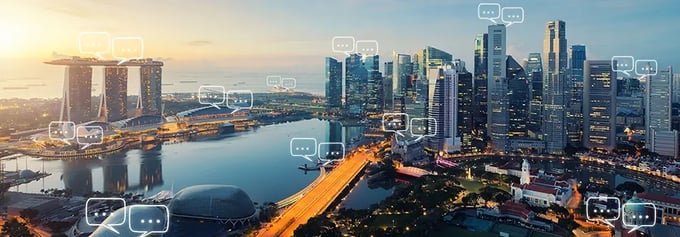Smart cities are seen as a progressive solution for creating and managing efficient and sustainable cities. They help reduce resources, lessen environmental damage, and improve the quality of life of city dwellers.
Smart cities are conceptually embracing the Internet of Things (IoT). It has a meaningful role in these cities as they become "smarter".
We’ll look at what a smart city is and why it’s important, particularly right now. We will explore how the IoT and related technologies can help create a smart city. Additionally, we will look at some examples of cities that are already using these technologies to become smarter and more sustainable.

What is a smart city?
There are a few different but overlapping definitions of a smart city. For the sake of clarity, we’re going to use the definition that a city is smart when:
It uses participatory governance and invests in human resources, social capital, and both traditional and modern infrastructure, thus ensuring sustainable economic growth, high quality of life, and the efficient use of natural resources.
This definition is flexible – creating a smart city shouldn’t be an all-or-nothing thing; it can be created in different ways; the key part is focusing on a set of priorities that make life better for everyone there.
And within that, as we’re focusing on the role of the Internet of Things, we’re interested in what technologies we can use to create smart cities.

Why are smart cities important?
We understand that smart projects can make our urban spaces sustainable, efficient and more livable. This is true both in theory and in practice. We have seen this through completed projects. And this isn’t some dream for the future: We can have this today.
And with more than two-thirds of humanity projected to live in cities by 2050, and growing environmental problems worldwide, we need to get “smarter” if we want to continue living this way.

How the Internet of Things makes smart cities possible
We can use data about how we live to improve the quality of life in cities. We can do this by using networked sensors and advanced software, such as machine learning and AI systems. This could cover lots of different things, but the ones most often talked about include:
- We can reduce our environmental impact, especially concerning climate change. Additionally, we can explore more environmentally-friendly ways to use natural spaces in and around urban areas. We track environmental data, such as CO2 levels and traffic conditions. We monitor and assist residents to find what they need in an eco-friendly manner.
- Improving water and energy infrastructure management – many cities are already using IoT tech to monitor and streamline their water and energy utilities.
- With smart water grids, we can track the amount and quality of water used within the city, along with smart water meters, and work to reduce over-consumption and loss through leaks or other structural problems within the grid.
- We can look for further efficiencies with smart energy grids by seeing usage patterns and optimizing accordingly. A popular example is the dimming of street lights to save energy.
- Optimizing waste removal – including tracking waste, alerting workers where receptacles are overflowing and finding ways to minimize the number of trips they need to take to a landfill or recycling facility.
And that’s to start. In addition, IoT has applications in other areas, such as public education and commerce. Below are some examples of cities worldwide using the IoT to become smarter.

Real-life examples of smart cities
Singapore
The International Institute for Management Development (IMD) maintains the Smart City Index that weighs on all the aspects of what makes a city smart and ranks them each year. Every year, Singapore has been number one.
It’s not difficult to understand why – the city-sized country has taken a very active and progressive approach to keep quality of life high and public services as efficient as possible. This is particularly notable in housing, employment, healthcare, waste management, and transportation.
As an example, Singapore has built an entirely digitized healthcare system. One of the notable IoT innovations they’ve introduced is wearable IoT devices for patients that transmit necessary data to their healthcare providers, allowing them to receive medical care at home and reducing the load on the city’s hospitals and in-patient facilities.
Newcastle-Upon-Tyne, United Kingdom
While Newcastle ranks 21st on the Smart City Index, it's the highest-ranked city in the United Kingdom.
A significant reason why the city ranks so highly has been the heavy investment in technological research, making it one of the fastest-growing hubs for digital and tech work in the UK. In addition, they’ve created a digital tool that tracks the location of all buses operating in the city, helping encourage more people to use public transport.
New York City
New York is ranked 12th on the Smart City Index, and has many initiatives that make it a smart city – not surprising, given its size and wealth.
Of particular interest is New York’s water management, which it has heavily invested in to give it smart technology throughout. It has hundreds of smart sensors throughout its grid that monitor its water infrastructure.
In addition, it has an automated water reading system made up of devices connected to water meters throughout the city. These automatically track usage that not only can be used by the city to manage its resources, but residents can also manage their usage daily and track their billing simultaneously.

We can make your city smarter too!
The sensors and software we make at LAIIER help make the world a better place by reducing wasted water. We all have a role to play in making our cities smarter, more sustainable and more liveable.
Much like the technologies we’ve highlighted above, ours help you detect leaks early as possible and warn you if a leak may about to happen. We’ve made them with special adhesives that fit around pipes, drains, and fittings like tape – in all those places where leaks often occur but are a pain to reach.
You can learn more about our technology here.